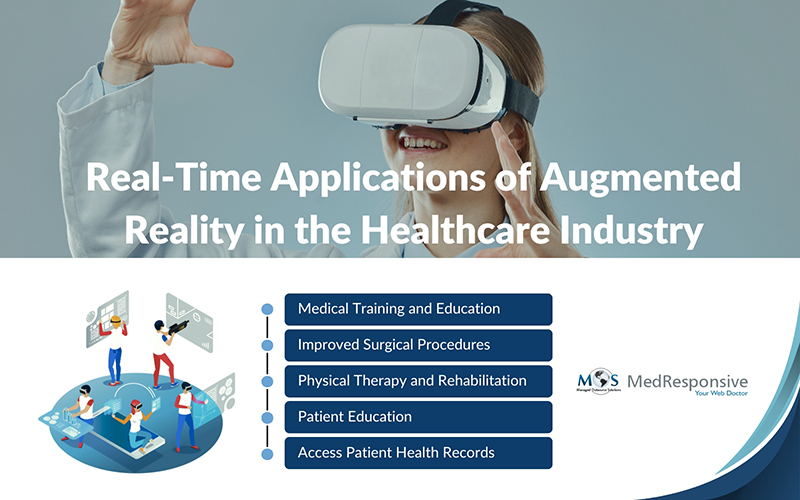How many of you remember the game Pokemon Go? The Augmented Reality (AR) mobile game that sent the world into a frenzy? Suddenly, people were seen wandering the streets, chasing virtual “pocket monsters” that appeared in their real-world surroundings.
Now, imagine augmented reality in healthcare. Think of Pokemon Go itself, but instead of chasing Pikachu, AR will be helping doctors diagnose diseases, perform treatments including surgeries, and train medical students without taking any risk.
Welcome to the world of augmented reality in healthcare — a realm that’s not just transforming how we diagnose and treat, but also redefining patient care. Augmented reality is having a significant impact on a range of industries, with many areas of healthcare being rapidly transformed by this futuristic technology.
What Is Augmented Reality in Healthcare?
Before we delve into its real-time applications, let us take a look into what AR actually means.
Simply put, augmented reality is the integration of digital data into the user’s environment in real time. In healthcare, AR will bring together the physical and digital elements, thereby enabling healthcare professionals to visualize in real and interact with patient data and treatment procedures in ways like never before.
Unlike Virtual Reality (VR), which transports users into a completely digitized environment, AR overlays digital elements like images, sounds and other sensory enhancements, in the real world. It would be similar to having an advanced “hybrid” assistant by your side.
Why AR in Healthcare Matters — A Few Solid Facts
| Global Market Growth Global AR in the healthcare market is valued at $2.01 billion in 2023 and is projected to reach $13 billion by 2030. |
Enhancing Surgical Procedures AR-assisted surgeries are found to reduce complications by up to 30%, improving recovery time. |
Reforming Medical Training Students, who were trained using AR, were found to retain upto 70% of information, compared to the traditional learning methods. |
| Training Cost Mitigation AR training tools save upto 60% of total costs incurred for traditional learning methods (i.e. travel, accommodation, food and other resources). |
AR for Medical Practice AR tools, used for patient assistance like AccuVein, improves vein detection accuracy by 3.5 times, making blood draws more accurate. |
AR for Pain Management AR therapy platforms were found to reduce pain perception for burn patients by up to 50%, by indulging them in calmer, stimulated environments. |
Benefits of Augmented Reality in Healthcare
- Medical Training and Education
AR has been a revolutionary aspect for medical training. By leveraging AR tools like Microsoft HoloLens or Meta Quest, students can now visualize and interact with the 3D models of human anatomy. These platforms offer interactive sessions, where students can literally take a “walk” through the nervous system or perform virtual surgeries on a patient, without putting any lives at risk.
- Improved Surgical Procedures
Now, surgical AR systems are available that are capable of providing real-time guidance. For instance, with AccuVein, healthcare professionals can make veins and bifurcations visible to the naked eye, thereby improving accuracy in IV placements. Surgeons can also use AR overlays to visualize patient-specific anatomy, reducing costly errors during operations and enhancing precision.
- Physical Therapy and Rehabilitation
Healthcare providers can make use of AR-based rehab programs to offer gamified activities that rejuvenate patients. NeuroRehab VR can create a bespoke therapeutic environment according to the requirements, thereby helping patients regain motor functions like mobility and sense, while tracking their progress with measurable insights.
- Patient Education
It is not just for medical students, but patients also get overwhelmed by complex medical jargon. AR can simplify this by providing visual explanation. Imagine an instance where an AR app can explain the process involved with knee replacement surgery or how their heart will look like, post-stent placement. If used correctly, AR can bridge the gap between doctors and patients.
- Access Patient Health Records
AR technology enables healthcare providers to seamlessly get access to patient records directly from the EMR system and have it in their field of vision, while attending a patient. AR glasses and interactive wearables free providers from going through stacks of documentation. AR enables them to simply scan a patient’s hospital wristband and view the entire patient history, right in front of them. This saves a lot of time required for diagnosis and decision-making.
Successful AR Applications in Medicine
- Johns Hopkins University: Surgeons at JHU successfully performed their first AR-guided spinal surgery. Later studies revealed that implementing AR in surgical procedures has enhanced accuracy and reduced surgery time.
- Cleveland Clinic: AR is being widely used in heart surgeries these days, which provide detailed 3D images to help doctors analyze the complex anatomy and make informed decisions.
- Children’s Hospital L.A: The Children’s Hospital in Los Angeles has partnered with Meta and using Oculus, they create AR and VR simulations for pediatric trauma training. These simulations allow healthcare professionals to practice medical emergency scenarios in a risk-free environment, enhancing their response to real-life situations.
What Are the Challenges Involved with AR in Healthcare?
Yes, AR has been a transformative technology sweeping through different aspects of healthcare, but it is not without its challenges:
- Implementation Cost: Even though the long-term benefits are very clear, the initial costs can be very expensive, especially for smaller healthcare facilities.
- Data Confidentiality: Data security is paramount, with sensitive patient data involved and it is important to adhere to all privacy regulations to avoid any legal implications.
- Staff Training: Another major hurdle involved is the adequate training for healthcare professionals. They need to be well-trained to use AR tools, which can drain time and resources.
- Regulatory Approvals: All AR platforms/tools must adhere to strict government regulations, which in turn can delay their deployment.
What Is the Future of AR in Healthcare?
Despite these minor bumps, the future ahead looks promising. With advancements in internet connectivity, rapid AI and AR hardware integration are expected to boost the adoption rates even higher. By 2030, expect AR to become as ubiquitous in hospitals, as stethoscopes are today.
Promising areas in which the technology could make inroads are AR-assisted surgeries, where surgeons will be able to perform the procedure much more efficiently and remote surgeries that can be guided from miles away. Another area is preventive healthcare, where there would be AR apps that can let users scan their bodies to look for any signs of medical distress, just like a high-tech mirror that doubles up as a health scanner.
The MedResponsive Advantage
Now that you have excellent AR solutions up your sleeve, what is required to complete the set is a collaboration with a futuristic search engine optimization company that specializes in crafting the best healthcare marketing strategies. We ensure your advanced AR healthcare solutions get the exposure they deserve, positioning them as pioneers in this rapidly advancing field.





